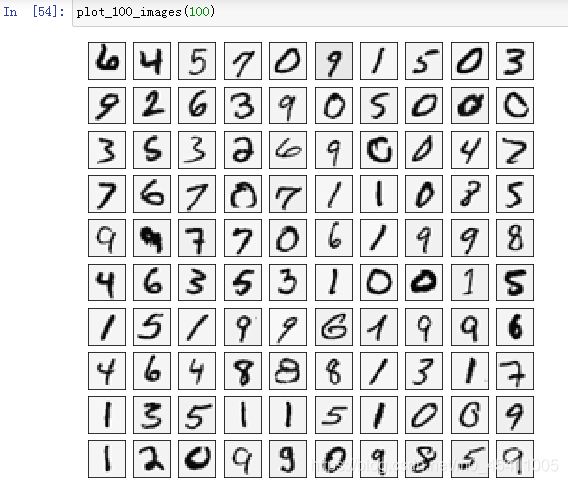机器学习python逻辑回归——多分类(吴恩达课后作业)
一、引入库和数据集
import numpy as np
import scipy.io as io
import matplotlib.pyplot as plt
data=io.loadmat('C:/Users/Administrator/Desktop/新建文件夹/ex3data1.mat') #type(data)-----dict
data.keys() #字典data的键有哪些,以列表的形式给出
#dict_keys(['__header__', '__version__', '__globals__', 'X', 'y'])
X=data['X'] #字典data对应键为'X'的值
y=data['y']
X.shape #(5000,400)
y.shape #(5000, 1)
np.unique(y)
#array([ 1, 2, 3, 4, 5, 6, 7, 8, 9, 10], dtype=uint8)
二、数据可视化
1.随机打印一个数字
def plot_a_image():
random_num=np.random.randint(0,5000) #根据给定的由低到高的范围抽取随机整数
image=X[random_num,:].reshape(20,20)
fig,ax=plt.subplots(figsize=(1,1))
ax.matshow(image.T,cmap='gray_r') #这里为什么要加转置呢?
'''不加转置的话,可视化的数字是反着的'''
plt.xticks([]) #去掉刻度,美观
plt.yticks([])
plt.show()
print('这应该是{}'.format(y[random_num]))
def plot_100_images():
random_sample=np.random.choice(range(0,5000),100) #range(X.shape[0])
images=X[random_sample,:] #(100,10)
y_images=y.ravel()[random_sample]
fig,ax_array=plt.subplots(figsize=(8,8),nrows=10,ncols=10,sharex=True,sharey=True)
for row in range(10):
for col in range(10):
ax_array[row,col].matshow((images[row*10+col].reshape(20,20)).T,cmap='gray_r')
plt.xticks([])
plt.yticks([])
plt.show()
fact_number=[]
for row in range(10):
for col in range(10):
fact_number.append(y_images[row*10+col])
fact_number=np.array(fact_number).reshape(10,10)
print(fact_number)
三、定义输入变量和标签变量
X=np.insert(X,0,1,axis=1) #(5000,401)
y=y.ravel() #(5000,)
theta=np.zeros(X.shape[1]) #(401,)
四、定义代价函数
1.代价函数
def sigmoid(z):
return 1/(1+np.exp(-z))
def cost(theta,X,y):
first=y@np.log(sigmoid(X@theta))
second=(1-y)@np.log(1-sigmoid(X@theta))
return (first+second)/(-len(X))
2.正则化后的代价函数
def costReg(theta,X,y,lam=1):
thetaReg=theta[1:]
reg=lam/(2*len(X))*np.sum(np.power(thetaReg,2))
return cost(theta,X,y)+reg
五、梯度函数
1.梯度函数
def gradient(theta,X,y):
return X.T@sigmoid(X@theta-y)/(-len(X))
2.正则化后的梯度函数
def gradientReg(theta,X,y,lam=1):
thetaReg=theta[1:] #第一项没有惩罚因子
reg=lam/(len(X))*thetaReg
reg=np.concatenate([np.array([0]),reg]) # np.concatenate()连接
return gradient(theta,X,y)+reg
六、一对多分类
np.unique(y)
#array([ 1, 2, 3, 4, 5, 6, 7, 8, 9, 10], dtype=uint8)
所以建立十个逻辑分类器,每个逻辑分类器是二分类。
import scipy.optimize as opt
def one_vs_all(X,y,K): #K是指要分成K个类
all_theta=np.zeros((K,X.shape[1])) # K个分类器的最终权重
for i in range(1,K+1): #因为y的取值为1,,,,10
theta=np.zeros(X.shape[1]) #第i个分类器的权重
y_i=np.array([1 if label==i else 0 for label in y])
#将y的值划分为二分类:0和1
res=opt.minimize(fun=costReg,x0=theta,args=(X,y_i,1),method='TNC',jac=gradientReg,options={'disp':True})
#Whether to print the result rather than returning it
all_theta[i-1,:]=res.x
return all_theta
all_theta=one_vs_all(X,y,10)
七、预测
all_theta.shape #(10,401)
def predict_all(theta,X):
h=sigmoid(X@theta.T)
y_argmax=np.argmax(h,axis=1)
y_pred=y_argmax+1
return y_pred
y_pred=predict_all(all_theta,X)
y_pred #array([10, 10, 10, ..., 9, 9, 7], dtype=int64)
y #array([10, 10, 10, ..., 9, 9, 9], dtype=uint8)
accuracy=np.mean(y_pred==y)
accuracy #0.9446




